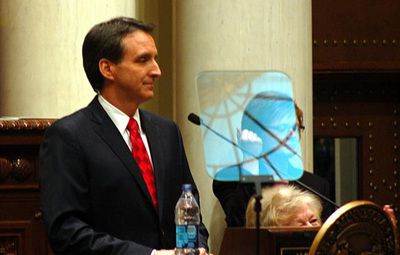Gov. Tim Pawlenty has adopted familiar themes in his State of the State address to the Legislature today.
-
Audio not found
“Minnesota’s tax structure is costing us jobs,” he said a few seconds ago, as he outlined a “jobs creation bill” that includes a tax incentives package to encourage job
creation, including a 20-percent corporate tax break and angel investment tax credits. He also proposed giving the Ford plant in St. Paul tax incentives modeled after his Job Opportunity Building Zones program.
Is Minnesota’s tax system costing jobs? Prove it.
The Freedom Foundation of Minnesota issued a report on Wednesday that said people are moving out of Minnesota, to states with more competitive tax rates. It listed the most popular destinations as Florida (21,256), Arizona (19,605), Wisconsin (9,449), Colorado (6,894) and Texas (6,551).
There are significant flaws in the study, beyond the fact the word “snow” appears only once.
“People are most inclined to move where taxes are lower (especially income taxes), union membership is lower, population density is higher, the cost of housing is lower, and the weather is warmer. Additionally, AGI is the most sensitive variable when it comes to state and local tax (and income tax) burdens, union membership and average temperature,” the report said. But it offered no proof of its conclusion.
The word “age” also did not appear in the report at all. How can one attribute an out-migration to union membership, if we don’t know the percentage of people leaving for sunnier climates who are retired?
It would appear the report started with a conclusion, and then built data around it; a not-unusual tactic for special-interest groups on both sides of the issue.
For example, I could conclude that when people leave Minnesota, they’re looking for more opportunities to be unemployed. Silly? Of course it is. But Florida (11.6%) , Arizona (8.8%) , Wisconsin (8.3%), and Texas (8%) all have higher unemployment rates than Minnesota (7.3%). Colorado has the same unemployment rate, but a better hockey team. So maybe people are moving there because of hockey.
The Tax Foundation released its annual survey last fall which ranks states by their “business friendly” nature, that is: taxes. It considered business tax, individual income tax, sales tax, unemployment tax and wealth and property taxes.
Minnesota was #43. Wisconsin was #42. So much for the theory that people are moving to Wisconsin because of taxes.
The 10 “best” states for business tax climate were South Dakota, Wyoming, Alaska, Nevada, Florida, Montana, New Hampshire, Delaware, Washington, and Utah.
South Dakota is where banks set up their operations, but it’s not where people move to. It ranks 46th in population (812, 383). True, 86,000 people have moved in, but 82,000 have moved out. For states gaining population, South Dakota has one of the lowest rates. Wisconsin has the lowest, according to a Pew Research study. South Dakota’s percentage of people born in the state and still living there, is one of the nation’s lowest. Minnesota, on the other hand, is one of the highest.
If the “business friendliness” of a state is all it takes to create and maintain jobs, how do we explain the fact that Wyoming (7.6%), Alaska (9%), Nevada (12.8%), Florida (11.6%), Delaware (8.6%), and Washington (9.5%) — that’s 6 of the top 10 — all have more joblessness than Minnesota?
Two of the “best” states — Florida and Nevada — lead the nation in foreclosures.
And one of the “worst” states — Iowa — has an unemployment rate that’s nearly half of the fourth-friendliest state for business.
Minnesota’s budget deficit in fiscal 2009 was huge, to be sure; it was 5.5% of the state’s General Fund. Three of the friendly states — New Hampshire (6.4%), Florida (11%), and Nevada (13.5%) — had budget deficits that were worse. In the current budget year, most of the states with the most severe budget problems, are states with a better tax rank than Minnesota.
Politicians try to make simple comparisons in support of their political agenda. Sometimes they’re right; sometimes they’re not. But it’s always important to question their assertions.
On MPR’s Midmorning the other day, St. Paul Mayor Chris Coleman defended taxes. “If no taxes was the key, then Mexico would be the richest and most successful country in the world,” he told a caller. He’s also wrong. Mexico has a maximum corporate tax rate of 35 percent on profits. Minnesota’s, by the way, is 9.8 percent on all corporate income.
But Coleman is probably right in saying businesses are looking for something else besides tax rates. One of these days, someone will determine exactly what that is, and perhaps define a vision for Minnesota that’s complicated enough to accommodate business.
In his speech today, Gov. Pawlenty said Minnesota Twist Drill’s expansion and creation of jobs shows the effect of tax breaks. What he didn’t say is the company recently expanded by adding a company in Illinois with the help of the Iron Range Resources Board. He also didn’t say that one of the reasons the company didn’t move out of state was two bank participation loans, a direct loan, and an employee grant from the IRRRB. an agency with a spotty record of investments.
How is the IRRRB funded? A tax on business.

